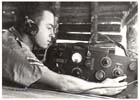Harvey’s experience of the war in New Guinea was, from the outset, largely one of disorganization and not knowing what was going on or why things were happening.
The conditions on board the ship on which he and his battalion were transported to New Guinea were such that the men never really knew what was going on. It was not until he disembarked at Port Moresby in early 1942, that he discovered where he had been sent. The journey saw the men quartered below the waterline inside the ship, in highly cramped conditions without operational fans for the entire trip; “it was just like a sweat box”.
Troubles continued even after arrival at Port Moresby. The ship was unable to dock because it was too large for the harbor. The men were ferried ashore only to find that they were without food and tents because the ammunition had been packed on top of them. So, at the start of the wet season the new troops were forced to camp out in the open with the mosquitoes and weather, sleeping wherever they could find a good patch. This was difficult as the ground was mostly rocky. Such first experiences in New Guinea generated very poor morale among the troops. Low morale then progressed to a sense of demoralization following the bombing of Port Moresby. The combination of the troops low spirits and the first experience of enemy attack saw looting, mainly for alcohol, break out in the Burns Philp stores.
Although Harvey was a signaler throughout the whole war, he was not entirely satisfied with his preparatory training. He had received very little training before being sent abroad and what he received while in active service in New Guinea seems to have been below what he had expected. For Harvey this flowed over into frustration as his work seemed to be focused on participation in work brigades, with even the specialist signals training being largely in the construction of an office rather than in learning and refining the skills of his position.
Confusion seems to have been a recurring theme in Harvey’s wartime experience. When serving on the Kokoda Track he was forced back by the Japanese, but was only later informed that he was going back to Moresby. However, he did not understand why he and the other men were going back, possibly as a result of the loss of his major and the colonel during that operation. The widespread depression of Harvey and fellow battalion members indicates the men were greatly affected by the sense of confusion and general lack of understanding of what was going on and its impact on them. This could only have been worsened by the dispersal of the battalion and the absence of any lines of communication, as well as by the very small rations- one tin of bully beef between seven men.
Kokoda (part 1):
 Overview text
Overview text Longer text
Longer text  Images
Images  Readings
Readings  Albert Moore
Albert Moore  Arnold Potts
Arnold Potts  Harvey Blundell
Harvey Blundell  Kiki Baiyane
Kiki Baiyane  Map
Map


